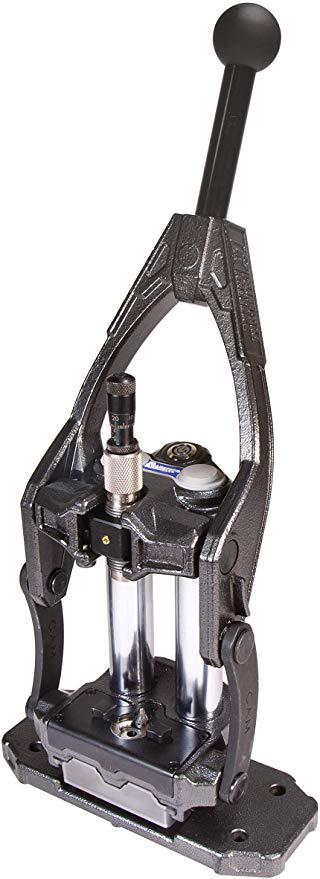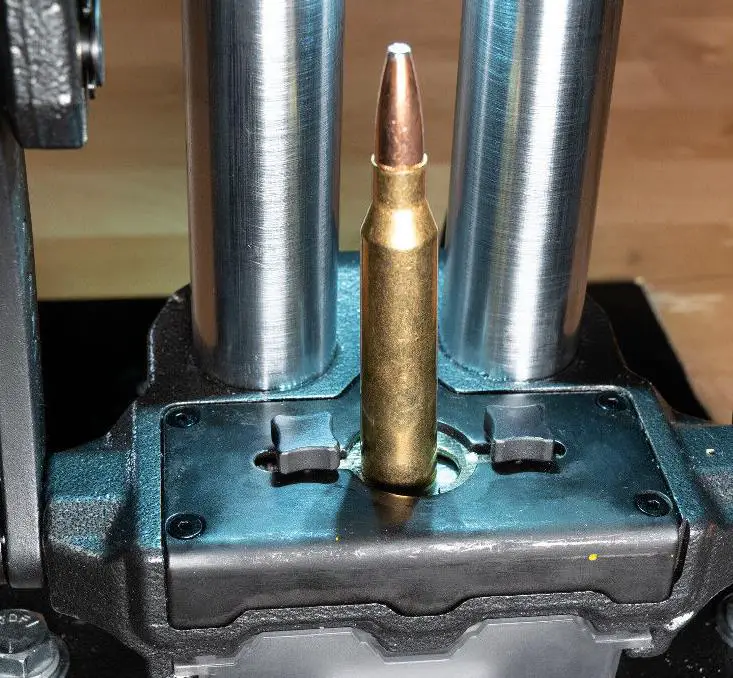Frankford Coaxial M-Press We wanted to give this new press a try since we have enjoyed using many of the F.A. products in the past, including their Deprimer and Priming tools, both of which are time savers and inexpensive. As with every reloading press on the market, there is an adjustment period to go through when getting used to a new machine. And, as with all presses, there are some pros and cons associated with it. However, once in place and you have “mastered” the ease of use with this new M-press, you will not want to use any other single-stage press on the market. Over the years we have used just about every single stage press on the market from an old reliable Pacific to the newer RCBS, Redding and Lyman presses. And yes, we have a Dillon multi-stage press which our daughter loves. But, for a “dinosaur” like Jim, the single-stage presses are his preferred units. He believes that he can be much more precise in his reloading with a single-stage press, which is why he wanted to give the new Frankford Arsenal Coaxial press a thorough workout. The first thing one notices with the M-press is the incredible ease with which the rams operate. The engineers made full use of the laws of physics with respect to levers. This press can be operated with two fingers for bullet seating…. the effort is completely handled by the coaxial design. The built-in light is very nice. We never knew what we were missing with other units until we got the M-press with its light that illuminated the area…other companies should take notes. Besides the ease of operation of the ram and the light, the M-press uses a completely new system for installing the reloading dies. This new system involves F.A.s patented Die Blocks. Six of them are included with the press, and one can order additional sets of three at a reasonable price from Midway.
Illustration courtesy of Frankford Arsenal To utilize the new system, you remove the lock ring from your reloading die (it is not needed) and screw the die into the Die Block which then is inserted into the M-Press. After the Die Block is inserted into the press. Then, you adjust the ball-point set screw on the left side of the M-press to lock the block in place. Your reloading die is screwed into place on the die block. It is then adjusted as you would with a regular single-stage press and “locked” in place with the brass block set-screw.When you are finished with that particular operation (such as resizing, bullet seating, etc) simply remove the Die Block, with your adjusted die, and set it aside for future use. Your die remains properly adjusted. This is a major positive for the F.A. press as everyone knows that even though the lock rings on dies were designed to keep their adjustment; however, screwing the die into and out of the presses almost always resulted in them not holding their position. Perhaps the most significant advancement in reloading incorporated into the M-Press is the universal shell holder system which adjusts easily for cartridges from small pistol (our .380s) to large pistol cases (.44 mags and .45s), and every rifle case that we had available (.223 up to .375 H&H). The shell holder is spring-loaded with four markings: Small, .223, .308 and Large; and, opens and closes like an iris. Specifically, those settings will fit the following cartridge cases:
The
universal shell holder works exceedingly well. Our only complaint is
that the square holder stems are difficult to grasp if you have large
hands or have a bit of arthritis. But, other than that minor
irritant, they work perfectly. The engineers at F.A. undoubtedly
envisioned the use of 2 – 3 Die Blocks for each set of
reloading
dies that you use (similarly to what is recommended on several
multi-stage presses). That could get a bit pricey. Instead, we
purchased one additional set of three and use the die blocks to
permanently adjust our most commonly used FL sizing dies. Sizing is
one of the most critical operations and worth the additional expense
to ensure that the FL die is properly and permanently adjusted. As
for the seating dies? Well, since we use a variety of bullets in each
caliber, the new adjustments are required for each new bullet type.
As such, we keep a Die Block “clear” and ready to
install into
the M-press when we are ready to seat our bullets. Screw-in the
seating die, adjust it, tighten the set-screw and start seating your
bullets, When done, release the tension on the die block set-screw
and remove the die. If you crimp a lot of bullets, it may be of value
to use a die block with a permanent setting for your crimp dies.
However, only you can make that determination… we don't
crimp very
often, so it was not cost-effective for us. The MSRP of the Coaxial M-Press is $270.99, but you can find it online for as low as $159.99 from Graf & Sons…. that is a real bargain and well worth the investment. We recommend this unit. |
